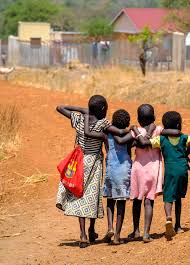Report Unmasks Intriguing Facts About State Of Uganda’s Children

The 45.9m people live in a total of 10,698,913 households whose average size is 4 persons. This is how the number of households is shared out among the statistics sub regions into which UBOS split the country: Buganda has over 3.4m households followed by Busoga with 965,399.
Others are Acholi with 466,128; Ankole 842,783; Bukedi 503,727; Bunyoro 663,258; Elgon 526,694; Karamoja 313,987; Kigezi 396,918; Lango 575,559; Teso 489,620; Tooro 776,484 and West Nile 754,623. There is a lot more that we shall be returning to in this regard, in our subsequent coverage but for today let’s focus on statistics relating to children who are the future of our country.
THE CHILDREN:
The 2024 census report shows that of the 45.9m people Uganda has, 22.2m (almost 50%) are children (defined as all human beings aged between 0 and 17 years). In 2014, it stood at 18.9m which comprised 55.3% of the country’s total population as of that time. And 13% of the 22.2m children of Uganda are orphaned, having lost both or one of their parents.
One of the very disturbing statistics about Uganda’a children is that in Karamoja, 82% of those aged 6 years have never joined or started school. The other intriguing finding is that 63% of Uganda’s children aged 5 and below don’t have their birth certificates as yet inspite of the fact that NIRA is there well decentralized and all the enabling laws are in place.
This therefore becomes one advocacy area for CSOs and other activist groups to focus on. Yet that isn’t all. This also means the births of these children were never registered nor certified with the relevant authority of government which is NIRA.
The Census report also reveals another disturbing finding namely that in Karamoja, 60% of children live in homes where open defecation is accepted practice. This speaks to sanitation challenges and the sub region’s limited access to toilet and other sanitation facilities.
The other worrying finding for Karamoja is the fact that 5 in every 10 children aged 14-17 (basically teenagers) are out of school and aren’t engaged in any form of economic activity either.
This Census data can guide the National Planning Authority and partners like UNICEF regarding the appropriate interventions that have to be designed to address issues relating to children rights, protection and welfare better.
These youngsters, ideally, are Uganda’s future labor or work force whose welfare ought to be comprehensively prioritized. This latest statistics should also guide the GoU in planning the appropriate educational, health and other social services interventions that are children-sensitive and children-specific.
MORE DETAILS:
Of the 22.2m Ugandan children (below 17), 9% are aged between 3-5; 27% under 8 years; 13% between 13 and 17 years; 19% of those aged 6-12 years are in primary school and 15% are under the age of 5. Basically, 13% are of the secondary school going age (13-17) and 19% of primary school going age (6-12 years). 27% are under the ECD education-enrolment age (0-8 years).
Karamoja tops chats when it comes to the sub region with the largest number of children as a proportion of the whole population: of the roughly 1.5m people living in Karamoja, 56% of them are children aged 0-17 years. Ankole sub region has the lowest proportion of the population that is comprised of children. Of the roughly 3.6m people living in Ankole, 45% are children aged 0-17 years.
Other sub regions fair as follows: Buganda has 46.44% of its 12.9m people comprising of children aged 17 years and below. It’s 54% in West Nile, 53% in Teso, Bukedi 53%, Tooro 52%, Bunyoro 52%, Busoga 52%, Acholi 51%, Lango 48.92%, Elgon 48% and Kigezi 47%.
When it comes to access to basic children human rights as enshrined in international instruments like the UN Convention on the Rights of the Child (CRC) and Uganda’s own legal framework, the Census report makes clear findings showing areas that require improvement.
Even when the Registration of Persons Act 2015 requires registration of every child within the first 90 days of his or her birth, the Census report shows that 63% of Uganda’s children aged 5 and below have never been registered.
To qualify them for citizenship, which is a basic right, the laws of Uganda, including Registration of Persons Act, require registration and certification of all children born in Uganda. Being issued with a birth certificate is the best form of proof and evidence that the GoU recognises citizenship of a given child.
The Census report shows that 51% of Uganda’s children under one (1) as of May 2024, hadn’t been registered at birth as would be ideal. And only 32% of the children aged one year and below had had their parents commence on the process to have them registered.
This implies that a whopping 68% of the parents aren’t bothered at all about having their children’s birth registered and subsequently certified. Not being registered and certified simply means there is no way government can be aware of those children let alone being in position to effectively plan for them. In most cases, parents commence on the registration and certification processes of their children but seldom follow through to the logical end.
When it comes to children without parents, basically orphaned (which technically is defined as losing one’s parent while under the age of 18), 13% of Uganda’s 22.2m children are double orphaned implying they lost both father and mother.
Three (3%) are maternal orphans and 6% are paternal orphaned-meaning they are without a father. In Karamoja, 19% of the children are orphaned, 19% in West Nile and 10% in Teso. The Census report shows that Teso sub region has the lowest number of orphaned children.
The same report shows that 7% of all children aged 12-17 years are victims of child marriages which UNICEF defines as a marriage union where one of the two partners is below 18 years.
The Census report makes it clear that early marriages in contemporary Uganda is a problem to which both boys and girls have been and continue to be victims. Whereas 9% of Uganda’s female children (aged 12-17) are in this sort of marriage, for males the number stands at 6%!
The problem of children marriages is more pronounced in Karamoja where 12 in every 100 children are in a child marriage. Its 8% in Lango statistics sub region. In our subsequent coverage of the 2024 Census report, we shall reflect on the proportion of Uganda’s children that is currently not going to school, the reasons why and much more.









0 Comments